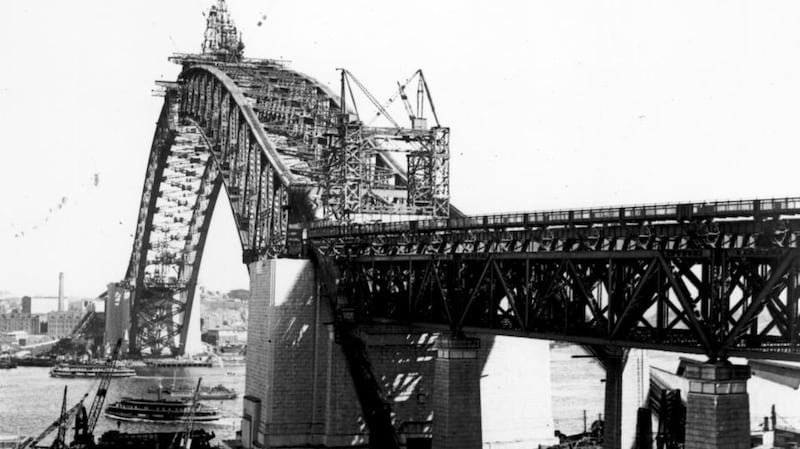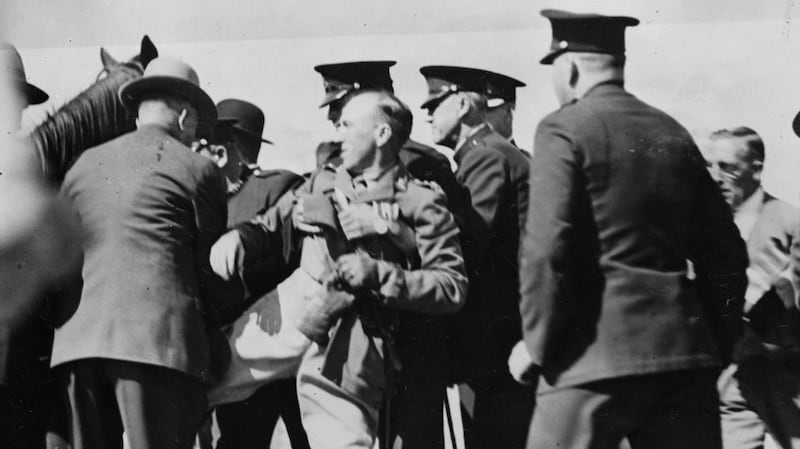Francis Edward De Groot was born in Dublin in 1888. By the time he and his Galway-born wife Mary arrived in Sydney in 1920, De Groot had served in the South of Ireland Imperial Yeomanry, and, with distinction, in the 15th Hussars. The Hussars were a cavalry regiment of the British Army; seeing action on the Western Front during the first World War.
Like many conservative Australian world war veterans, De Groot joined the New Guard in Sydney; a right-wing, proto-fascist militia, which boasted a membership in excess of 50,000. Funded by large banks and insurance companies, one of the New Guard objectives was to crush communism and to pledge unswervingly loyalty to the British Empire. Many New Guard branches flew the red swastika flag of the Nazi Germany and some members even saw fit to don the garb of the Klu Klux Klan.
De Groot infamously garnered an enduring notoriety in Australian folklore at the opening of the Sydney Harbour Bridge on March 19th, 1932. The event was an auspicious much anticipated occasion with a crowd estimated at up to 500,000 at the opening ceremony. Thousands had travelled from all over Australia to witness the spectacle.
World’s largest bridge
After six years, work on the bridge was completed in 1932, some 41 years before the construction of that city’s other iconic landmark, the Sydney Opera House. Surprisingly, only 16 men lost their lives during its construction.

To this day, the bridge remains a remarkable engineering feat. Spanning 1149 metres and boasting an arch span of 503 metres, it remains the world’s largest steel-arch bridge. Affectionally dubbed the coat hanger by locals, it’s an imposing steel structure on the Sydney skyline. Built over six years by the UK firm, Dorman Long & Co of Middlesbrough, it has an astonishing six million hand driven rivets and it is held together by huge hinges, specially designed to expand and contract under the ferocious heat of the Australian sun.
Boasting eight lanes for vehicles, two train tracks and a bicycle lane, the bridge serves as a vital link between the northern and southern Sydney suburbs. Its construction is all the more remarkable given it was built during the Great Depression, when Australia’s had a population of just eight million, and almost half a million were unemployed. Soup kitchens were set up all over the country to feed the starving populace.
Jack Lang, the left-leaning Labour Premier of New South Wales at the time, was an ardent anti-monarchist and viewed by many of his critics as having communist tendencies. To his credit, Lang flatly rejected any austerity measures that had been recommended by the visiting Sir Otto Niemeyer of the Bank of England.
Niemeyer had urged savage cuts to social welfare and wages in order to make Australia’s exports more competitive. Instead, Lang introduced a raft of social reforms including widows’ pensions, child endowments and workers’ compensation. Lang insisted that given the perilous state of the Australian economy, no Australian should be expected to foot Britain’s war bill and he suspended all payments to overseas creditors. Needless to say, Lang was reviled by De Groot and the New Guard.
Lang had insisted that as Premier, he would be the one to cut the ribbon; so, no invitation to any members of the Royal Family was forthcoming Although, it was widely reported that King George the 5th was also keen to have the honour.
Arrest
But before Lang could formally cut the ribbon, De Groot, who’d dusted off his Hussar uniform, borrowed a friend’s horse and surreptitiously joined the uniformed escort party of NSW Lancers, charged forward, and to the consternation of the crowd, with a dramatic flourish of his ceremonial sword, cut the ribbon. Presumably to add some gravitas to his deed, he declared he was opening the bridge “in the name of the decent and respectable people of New South Wales.” By decent people, no doubt, he meant those who shared his political persuasion.

De Groot was unceremoniously knocked off his mount by a policeman, arrested and swiftly deposited in the Lunatic Reception House in Darlinghurst. The assumption being that he must have been unhinged to perform such a dastardly deed. But after examinations by at least three psychiatrists, and to Premier Lang’s chagrin, he was deemed to be sane.
He was subsequently found guilty of offensive behaviour in a public place and fined £5 and £4 in costs. He later sued for wrongful arrest - arguing that a policeman had no right to arrest a Hussar officer - and reportedly, he received a substantial out of court settlement and had his aforementioned sword returned to his possession.
De Groot went on to run a successful high-end antique dealing and furniture manufacturing business in Sydney. However, like many migrants, he must have held a special place for Ireland in his heart, for he and his wife returned to Dublin for good in 1950, and he died in a Dublin nursing home in 1969. His would-be nemesis, Premier Lang had been dismissed by the Governor of NSW within two months of the bridge’s opening, thereby effectively ending his political career.
In a footnote of sorts, De Groot’s sword was located at his nephew’s farm in Wicklow in 2004. It was subsequently purchased by the owner of BridgeClimb, the company that offers the public the experience of climbing the 1,000 plus steps up to the summit of the coat hanger. Alas, the sword is not available for public viewing.










